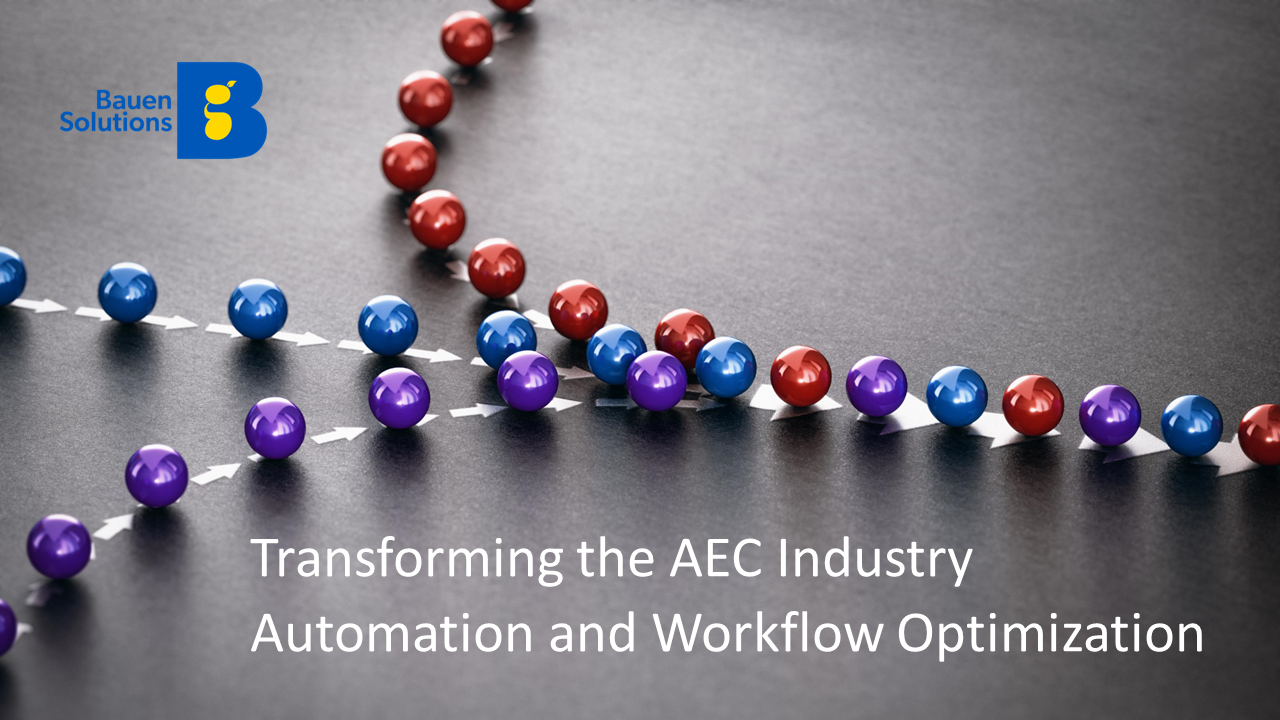Transforming the AEC Industry Automation and Workflow Optimization
Automation and workflow optimization are revolutionizing the Architecture, Engineering, and Construction (AEC) industry. With advancements in technology, AEC professionals are embracing automation tools and strategies to streamline processes, reduce errors, and enhance productivity.
This blog explores the transformative impact of automation and workflow optimization in the AEC industry. From design and documentation to construction and project management, we delve into the benefits of automation, such as increased efficiency, improved collaboration, enhanced accuracy, and cost savings.

Design and Modeling Automation
Automation is reshaping the design and modeling processes in the AEC industry. Building Information Modeling (BIM) tools, coupled with automation features, enable the automatic generation of 3D models, eliminating manual modeling efforts. Parametric design tools allow architects and engineers to define design constraints and parameters, enabling the automatic adjustment of design elements.
This automation not only speeds up the design process but also ensures design consistency and accuracy. Additionally, automated clash detection identifies potential conflicts between building components, reducing errors and rework during the construction phase.
Document and Drawing Automation
Automation and workflow optimization play a crucial role in the creation and management of project documents and drawings. Software tools automate repetitive tasks such as title block generation, sheet numbering, and revision tracking, freeing up valuable time for AEC professionals to focus on higher-value activities.
By automating the creation of drawing sets and document templates, consistency and standardization are improved, reducing errors, and enhancing collaboration among project stakeholders. Furthermore, automated document management systems facilitate version control, ensuring that the latest revisions are accessible to all team members, leading to seamless collaboration and avoiding confusion caused by outdated documents.

Construction and Fabrication Automation
Automation and workflow optimization have significant implications for construction and fabrication processes. Robotics and automation technologies are being increasingly utilized in construction sites, reducing labor-intensive tasks, enhancing safety, and improving productivity. Robotic equipment can perform repetitive tasks such as bricklaying, concrete pouring, and material handling, leading to faster construction timelines and cost savings.
Prefabrication and modular construction methods are also benefiting from automation, as components can be manufactured off-site using automated processes, reducing construction time and increasing quality control. Additionally, automated equipment tracking systems and real-time progress monitoring enable project managers to monitor construction activities, identify bottlenecks, and make informed decisions promptly.

Project Management and Collaboration Optimization
Automation and workflow optimization significantly impact project management and collaboration in the AEC industry. Project management software automates tasks such as scheduling, resource allocation, and progress tracking, allowing project managers to focus on critical decision-making rather than administrative tasks. Workflow optimization techniques, such as process mapping and analysis, help identify inefficiencies and streamline project workflows, leading to improved productivity and reduced delays.
Collaboration platforms and communication tools facilitate real-time collaboration among project stakeholders, ensuring seamless information exchange and decision-making. By automating communication and collaboration processes, teams can share project updates, monitor tasks, and address issues promptly, enhancing overall project efficiency.
Cost Savings and Efficiency Gains
Automation and workflow optimization bring substantial cost savings and efficiency gains to the AEC industry. By automating repetitive tasks and eliminating manual errors, organizations can reduce project costs associated with rework and delays. Automated processes also enhance resource utilization, as tasks can be scheduled and allocated more efficiently.
Workflow optimization helps identify process bottlenecks, enabling organizations to streamline operations and allocate resources effectively. Additionally, automation reduces paperwork and manual documentation efforts, saving time and reducing administrative costs. The improved accuracy and speed achieved through automation lead to faster project delivery, enhancing client satisfaction and potentially generating repeat business.
Automation and workflow optimization are transforming the AEC industry, enabling professionals to streamline processes, improve collaboration, increase accuracy, and achieve cost savings. From design and documentation to construction and project management, automation tools and strategies are revolutionizing how AEC professional’s work. By embracing automation, organizations can enhance productivity, reduce errors, and deliver projects more efficiently.
As technology continues to advance, the AEC industry must leverage automation and workflow optimization to stay competitive and drive innovation. The future of the AEC industry relies on harnessing the power of automation to create sustainable, efficient, and collaborative built environments.

Bauen Solutions has emerged as a leading player in empowering the AEC industry with data-driven decision-making and business intelligence. Through their innovative technologies and comprehensive solutions, Bauen Solutions has revolutionized how stakeholders in the industry tackle challenges. By leveraging advanced analytics, machine learning algorithms, and cloud-based platforms, Bauen Solutions enables organizations to access and analyze vast amounts of data in real-time. This empowers them to make informed decisions throughout the project lifecycle, from planning and design to construction and operation.
Bauen Solutions’ expertise in data integration, visualization, and predictive modeling has helped AEC professionals optimize resource allocation, mitigate risks, improve project outcomes, and drive overall efficiency. With Bauen Solutions’ cutting-edge tools and services, the AEC industry can navigate complex challenges with confidence and achieve unprecedented levels of success.
With Bauen Solutions as a driving force, the AEC industry is experiencing significant improvements in project management, communication, safety, resource management, document handling, and data analysis.
My name is Walter Silin, and I’m the President of Bauen Solutions. Our team of experts have decades of experience and specializes in helping Architecture Engineering and Construction firms like yours identify areas where material management can be improved, including:
- Inventory management
- Material handling and transportation
- Quality control
- Cost management
- Sustainability
We can help AEC organizations automate material management processes, improve inventory tracking, monitor quality control, and optimize material usage to improve efficiency, reduce costs, and improve your sustainability performance.
If you want to learn more about how we could benefit your organization, please schedule a call with me to discuss this further.






